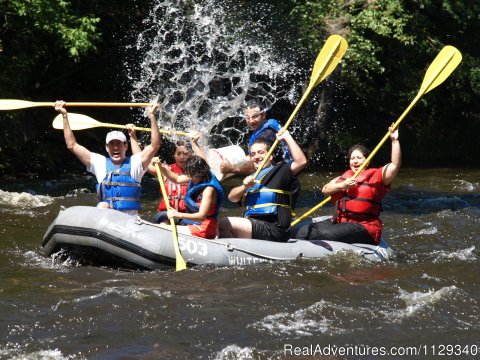Checklist and Frequently Asked River Rafting Questions
1.What do we wear? In cold weather or water, a wet suit is best. These can always be rented at our rafting center. In milder conditions, a wool sweater or windbreaker is ideal. In warm summer weather, a swimsuit or shorts and T-shirt are appropriate. Always wear laced shoes with sturdy soles (wet suit boots or old sneakers are great). Loose-fitting sandals, flip-flops, "crocs" . bare feet and river socks are not permitted. Also, in cool or cold conditions avoid wearing cotton, either on its own, or under a wet suit or windbreaker. Cotton, when wet, loses all insulation value and will make you colder, not warmer. A ski-type cap is very important in colder weather, and a baseball cap, visor, or sunglasses are helpful in bright, sunny weather.
2.What can we bring? In the raft, bring as little as possible...on the Lehigh River, a light lunch, on our other rivers, a candy bar or light snack. If there is medication you do or might require, keep it with you on the river. Towels, dry clothes, valuables, and other than waterproof cameras should be left locked in your car.
3.How do we get back at the end of the day? Your vehicle will remain at our rafting center, and our free shuttle buses will take you to and from the river.
4.How deep is the water? River depths vary. Slow, calmer stretches of water tend to be those that are deeper. Faster, choppy water tends to be shallow, often 4 feet deep or less. Regardless of the depth, however, if you should find yourself overboard (this is rare, indeed) in fast moving water, the proper procedure is to float on your back, feet pointed downstream, and not attempt to stand until the water is less than 18 inches deep. A guide or nearby raft will assist you, or you may prefer to simply swim to shore.
5.Do I have to know how to swim? Swimming ability is not required. (Nevertheless, if you are especially apprehensive in or around water, you may want to consider one of our land-based adventures, ex: Mountain Biking, ZipLine Adventure. Rafting, by its nature, places you on, in or around water most of the day.) On all of our trips a PFD is worn at all times. Safety equipment will not fit all shapes and sizes, so please consider this in planning your reservations. Also, please remember that whitewater rafting is an active sport that requires some exertion on your part. The larger the rapids, the better your physical conditioning should be.
6.How big are the rapids? Rapids are rated from Class I (easiest) to Class V (most challenging). Class VI is considered to be not navigable without unreasonable risk of injury. Our easiest trips feature Class I or II rapids. At the Lehigh River, our more exciting trips feature Class III whitewater. At the Hudson and Black Rivers in New York, you'll find Class IV rapids.
7.Do I need experience? All our trips are open to first time rafters.
8.How old must I be? Minimum age for our easiest trips is 5. Other trips post minimum ages of 8, 10, 12, 14, 16 and 18. Please refer to individual trip descriptions for specific minimum age requirements.
9.How do I decide which river to run? For youth groups, families and first timers, we generally recommend beginning with a trip on the easier portion of the Lehigh River, the Salmon River, the middle Moose River or a summertime trip on the Hudson River. For a more challenging adventure, select a Dam Release Lehigh River trip, a summertime Black River trip, or a Springtime Hudson River trip. For very challenging whitewater, choose the Black River in May or early June, or the Hudson River in April.
 Bail Bucket Splash on the Lehigh (enlarge)
Bail Bucket Splash on the Lehigh (enlarge)